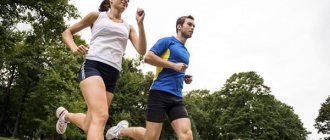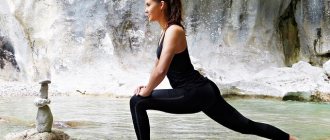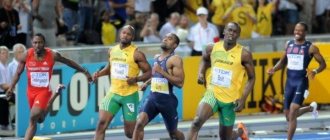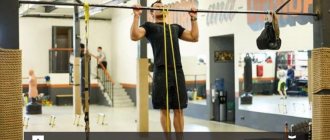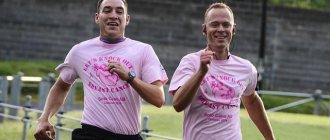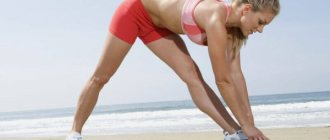If you've ever been to physical education, then you're probably familiar with smooth running. Based on the name, it already becomes clear that this technique is based on a flat surface of the path without any sudden changes in heights or other obstacles. If you want to improve your technique and show better results, then smooth running is what you need
Athletics areas
Disciplines included in the Olympic program. Let us examine in detail the types of running used in athletics.
Most courses in world competitions are flat surfaces. This is where the term “smooth running” was born. In essence, the concept means high-speed movement on the stadium surface, which does not have hills or slopes. Examples are relay and sprint.
Sprint
Competitions based on speed covering short distances (60, 100, 200, 400 meters). Sprinters are the fastest athletes in athletics. Thanks to this, their races are the most spectacular. Sometimes victory and defeat depend on hundredths of a second. In addition to the physical preparation of the athlete, the results are influenced by the starting technique, foot placement, arm movements, quality of shoes, etc.
https://www.youtube.com/watch?v=3C0wBaLT6so
A special feature of sprinting is the anaerobic (power) type of load. The athlete receives energy for movement not from oxygen, but from water and glycogen reserves in the muscles. Because of this, the peak speed occurs after 40–60 meters, and then there is a decline. The athlete’s task is to correctly calculate the possibilities so as not to waste energy in the middle of the distance.
Famous runners: Usain Bolt, Maurice Greene, Alexander Brednev.
Middle distance running
An athletics discipline in which the length of the competitive segment is longer than the sprint, but shorter than the stayer distance. At the Olympics, races are held for 800 and 1500 meters. Longer events (2000 m, 3000 m) have never been used at world championships. Most often, races of 2000 m or more are commercial or are used by athletes to prepare for major competitions.
The task of a middle-distance runner is to develop tactics for overcoming the segment. Athletes start in anaerobic (strength) mode, using internal reserves as a source of energy. After this, they gradually switch to aerobic respiration in order to use oxygen in the processes of energy exchange.
Famous athletes: David Rudisha, Yuri Borzakovsky, Maria Savinova.
Stayer's running
A discipline in which an athlete overcomes long distances - from 3000 m or more. Olympic races include 5,000 and 10,000 m races. Long-distance competitions are often held not in stadiums, but on the highway.
The tactics are different from sprinting. The stayer does not use a power start. He gradually picks up a competitive pace and maintains it throughout the race, only speeding up in the latter stages.
A special feature of stayer running is aerobic exercise. The athlete's body uses oxygen for redox processes. As a result, the athlete is able to cover long distances. Externally, stayers are easily recognized by their relatively small muscle mass and low percentage of subcutaneous fat.
Famous stayers: Mo Farah, Kenenis Bekele, Tirunesh Dibaba.
Marathon
A long race of 42 km 195 m. Included in the Olympic program. Half-distance championships are also organized - half marathons. The competitions are not held at the stadium, but on a specially fenced section of the highway. Since the distance is very long, food and drink points are installed every 5 km. This helps athletes maintain dwindling energy reserves.
Marathon running is not suitable for beginners. Before entering the competition, you must undergo intensive training in a special school. The minimum training cycle time is 6–7 months. The main task of an athlete during the preparation period is to “teach” the body to store more than 600 g of glycogen. Carbohydrate diets are used for this.
Famous marathon runners: Eliud Kipchoge, Dennis Kimetto, Emmanuel Mutai.
Relay race
Team athletics competition. The distance is divided into segments. Each running stage, athletes replace each other. The Olympic program includes distances of 4x100 m and 4x400 m. The world championships also include the following relay races: 4x200 m, 4x800 m, 4x1500 m. Each stage, in fact, is a sprint race for the athlete, which he needs to complete as quickly as possible.
The symbol of the relay is a baton passed between athletes of the same team. The competition has strict rules. For example, it is prohibited to pass a baton outside a special section of the distance. Obstructing athletes of the other team from passing the section is also punishable. But the most common mistake is losing the stick.
4x100m record team: Usain Bolt, Nesta Carter, Michael Frater, Yohan Blake.
Hurdling
A discipline included in the Olympic standings. The basis is running over several hurdles, the height of which varies from 700 to 1000 m. Races are carried out at 50, 60, 100, 110, 400 m. Hurdling is demanding in terms of technique. For example, an athlete should not jump over an obstacle, but “step over it.” The second important point is the rapid increase in speed after overcoming barriers.
According to the rules, the runner does not receive a penalty for knocking down obstacles. But every fall of the barrier affects the loss of fractions of a second, which become decisive in the race. The competition regulations prohibit throwing a limb outside the barrier and deliberately knocking down an obstacle. In general, such running presupposes the sprint specialization of athletes.
Famous champions: Sergey Shubenkov, Omar McLeod, Aris Merritt.
Steeplechase
A discipline included in the Olympic program. Distance - 3000 m. The track has 35 obstacles. The most “treacherous” are water holes, in which athletes often slip and fall. The design of the barriers has also been changed - they are wide, monolithic, and rigidly positioned. The rules allow you to overcome obstacles by stepping on them. This saves energy, but takes away precious seconds.
The athlete’s task is to distribute forces over the entire distance and overcome obstacles. The athlete's training must correspond to the level of a middle-distance runner. Additionally, jumping over barriers is practiced. By the way, special shoes are used for steeplechase, with the function of eliminating water.
Famous champions: Saif Said Shahin, Ruth Jebet, Gulnara Galkina-Samitova.
Barrier Sprint
It differs from smooth in that runners at a distance overcome obstacles - barriers. Hurdlers compete at distances of 110 and 400 m (men), 100 and 200 m (women). Athletes run along separate tracks, each with 10 barriers. Participants in these races are allowed to unintentionally knock down barriers, but if the barrier is knocked down on purpose, the athlete who did this will be disqualified.
The program of international competitions includes sprint relays for 4 x 100m and 4 x 400m, both for men and women.
Amateur running
We looked at professional disciplines. Now let's look at simple running options that are suitable for independent training.
Jogging or jogging
The most accessible and simplest type of jogging. Used to maintain health, as well as in weight loss programs as an effective physical activity.
Jogging - jogging at a speed of 7–9 km/h. Any distance, according to the wishes and goals of the athlete. As a rule, the training duration is 50–60 minutes. This time is enough for the body to use up glycogen reserves and use up fat deposits.
The peculiarity of jogging is that with minimal forward movement and a short “flight” phase, the athlete retains the beneficial properties of running at higher speeds. When conducting such classes, it is necessary to eliminate the following errors:
- sitting too tight on the legs;
- placing the foot on the heel without pushing with the toe;
- excessive forward lean.
All this reduces efficiency and accelerates leg muscle fatigue.
Posture running method
Originally developed by athlete and coach Nikolai Romanov, who trained the British triathlon team for the Olympic Games in 2000 and 2004. Romanov claims that his technique can improve performance in many disciplines.
https://www.youtube.com/watch?v=XoO3QKV3RQg
In Russia, a methodologist does not conduct seminars or train people. Therefore, you can find a complete description of his approach to training in the book “The Pose Method of Running.”
Let's look at the principles of movement along Romanov. The main thing is the pose (hence the name). Imagine a line running vertically through the top of your head, your pelvis, and the front of your supporting foot. Then create a slight fall forward and cross your other leg. Alternately changing limbs, you will move.
It is important that the feet should not extend beyond the pelvic line. The movement of the legs is reminiscent of pedaling a bicycle.
Running in place
Typically used as an alternative to street training. Allows you to strengthen the cardiovascular system, tighten body muscles, and burn calories at home. Can be used instead of morning exercises or for warming up during prolonged sedentary work. The benefits include improved digestion, as well as relief from depression.
There are different techniques for running in place:
- classical;
- with high hip lift;
- with choking of the legs.
By combining execution methods, you can control the load. To create a healing effect, it is better to “run” on the balcony or with an open window (in the warm season, of course). This will increase the filling of the blood with pure oxygen. To increase the load, we recommend using sand weights on the shins.
Running up the stairs
Used to strengthen leg muscles and lose excess weight. Additionally, ligaments, tendons, and small stabilizing muscles throughout the body are worked out. This allows for improved balance and coordination. The weight loss effect is explained by high calorie consumption due to the inclusion of large muscle groups in the work. Of course, you shouldn’t forget about following a low-carb diet.
For classes you will need stable sneakers with non-slip soles. Before you go to the entrance, you should stretch your legs well using a skipping rope or jogging in place.
If you are a beginner, start with fast steps for 15 minutes. In this case, the number of floors should be at least 4–5. After 6-7 such sessions, move on to easy runs. During your workout, keep your heart rate in the aerobic zone.
Running with weights
Additional weight may come in the form of shin pads or a special belt. Untrained athletes do not need such equipment. Beginners are advised to start with simple loads and gradually increase intensity. This is necessary so that the muscle tissue grows small capillaries and the ligaments are strengthened. A gradual increase in loads gives a positive effect in training.
Trained athletes use weights to better work out muscles and train the cardiovascular and respiratory systems. At the same time, the running technique remains the same.
We recommend using weight pads from 0.5 to 5 kg. Heavy projectiles can cause damage to the ligamentous apparatus.
Before using leg weights, be sure to stretch your knee joints.
Interval running
The most effective way to burn subcutaneous fat. Interval training involves alternating periods of intense running with periods of active recovery. Example of an interval program lasting 20–25 minutes:
- 100 m - jogging;
- 100 m - acceleration;
- 100 m - fast step;
- the circle repeats.
This method of training is not recommended for overweight people and beginner athletes, as it strains the heart.
In addition to losing weight, the benefits of interval running are increasing endurance, strengthening body muscles, and accelerating metabolic processes. Classes last no more than 30 minutes. Thanks to varied loads, during this time the body has time to use up glucose reserves and begin burning fat. The interval method is also used on cardio equipment (orbitrack, bicycle ergometer, treadmill).
Fartlek
System developed by Swedish trainer Guest Helmer. In fact, it is a variation of interval training. Can be used not only in running activities, but also in other disciplines (rowing, swimming, etc.). If we consider fartlek as a jogging technique, then it will be based on intense stages, between which recovery breaks are made. The duration of the workout is 35–40 minutes.
The difference between fartlek and standard interval training is the rest time. In fartlek, recovery lasts 3-4 times longer than the period of exercise. The rest is the familiar interval running.
Advantages of this type of training:
- reduction of fat layer;
- strengthening the cardiovascular and respiratory systems;
- tightening problem areas in women;
- improvement of general well-being and mood.
Cross
Running training on rough terrain (a piece of land with difficult terrain for movement). Thanks to the fresh air, cross-country running is considered the best form of running for health. An uneven surface forces an athlete to expend more calories when moving, which has a positive effect on weight loss. And the supply of pure oxygen improves lung function and improves mood.
Since the athlete moves off-road, the risk of twisting the foot increases. To avoid injury, before the cross-country it is necessary to warm up the muscles and joints of the legs well.
The training itself usually lasts from 40 minutes to 1.5 hours. The jogging speed is slightly higher than the jogging pace. Choose specialized shoes for cross-country. Hiking shoes with moisture-wicking features are best.
Shuttle run
High-speed movements with constant changes of direction. Typically, the athlete moves between two points - forward and backward. The number of runs in each direction is determined by the purpose of the lesson. The pace of shuttle running is maximum. The athlete accelerates to the end of the designated segment, then turns around and runs in the opposite direction. At each point you need to touch the floor with your hand to fix the position.
https://www.youtube.com/watch?v=CmbSkW8ycgI
The benefits of such runs:
- development of “explosive” force with the legs;
- increasing speed characteristics;
- muscle strengthening;
- burning subcutaneous fat;
- improved coordination and balance of the body.
If you want to do shuttle running, we recommend that you first practice your movement technique by light jogging back and forth, touching the floor at each point. This will help the muscles adapt to the load faster.
Rogaine
A type of active recreation, an analogue of orienteering. Competitions are held in both team and individual competitions. The participants’ task is to get as many points as possible, which are awarded for completing stages of the distance. The main difference between rogaining and orienteering is that runners know in advance where the control points are located and plan the route.
The duration of Rogaine starts from 3 hours and goes up to a day. The main type of movement is running. Competitions are also held for older people. In this case, running is replaced with Nordic walking.
Rogaine has similar effects on the body to cross-country sports. Athletes receive high-quality physical activity, burn subcutaneous fat, and improve their overall well-being due to frequent inhalation of pure oxygen.
Why run sprint distances?
Sprint running seems simple at first glance. In fact, an athlete has to give his maximum effort in a short period of time. Speed qualities and coordination of movements play an important role, but without proper technique, even the most promising sprinter will stumble in terms of results.
Short distances are not for everyone, but many athletes see their special charm. Low start, acceleration, distance running and fast finish: each race is like a small battle. And you should start sprinting not only to experience these sensations over and over again.
For children, sprinting is a great way to feel the spirit of competition and develop speed. In addition, athletics and specifically sprinting develop the muscular skeleton and endurance. It is important, of course, to follow the right approach to training and recovery to minimize injuries.
Another advantage of this type: fairly modest expenses. More on this later.
Let's roughly divide sprinters into three categories:
- Beginners: people who are just starting out or remain at the initial amateur level;
- intermediate level: athletes who participate in competitions but do not have income from sports;
- professionals: have income and perform at major competitions
| Initial Investment | 5000 – 13 000 ₽ |
| Purchasing additional accessories | 6000 – 10 000 ₽ |
| Spending at an amateur level | 30 000 – 40 000 ₽ |
| Spending like a pro | 40 000 – 50 000 ₽ |
| Average salary of sprinters competing at the Russian level | 15 000 – 30 000 ₽ |
| Average salary of world-class sprinters | 80 000 – 150 000 ₽ |
What to choose?
The choice of sports direction depends on the goals. If you want to lose weight quickly and are not shy about exercising outside, then suitable disciplines would be jogging, fartlek and interval running. For those who want to make their figure slimmer without leaving home, we recommend running exercises on stairs and in one place. Fans of active outdoor recreation will appreciate Rogaining and cross-training.
If your dream is to run a full marathon, you can't do it without an experienced mentor. Sign up for special preparatory courses, where you will be given a training system and taught how to eat properly.
Well, if you are choosing a sports section for a child, we recommend athletics. Even if the child does not become a champion, he will still receive an athletic “base” that he will apply in other sports and in life.
History of athletics
Athletics exercises were created by life itself. Running, jumping, throwing - all this served the practical purposes of ancient man. But the history of athletics as a sport began at the Olympic Games of 776 BC in Ancient Greece.
However, the queen of sports began to acquire a modern form only in the 20th century, experiencing rapid development and spread. This was, in particular, influenced by the revival of the Olympics in 1896.
In Russia by that time, athletics was slowly but surely developing. The beginning of her journey is considered to be 1888, the village of Tyarlevo, located near St. Petersburg. A sports club was organized there, which held the first running competition in Russia.
Seven years later, Russian athletics consisted of running, walking, cross-country, hurdles, shot put, leather ball throwing, triple jump both standing and running, long jump and high jump with and without running.
Our athletes went to the Olympics for the first time in 1912. A team of 47 athletes went to Stockholm, but did not bring any medals home. That same year, the modern governing body, the International Association of Athletics Federations (IAAF), was created.
However, at the end of 2022, the organization rebranded, and now it is called World Athletics. Note that until the end of the 70s, the name of the International Federation contained the words “among amateurs,” but in recognition of the movement of athletics towards professionalism, the word “amateur” was excluded.
marathon and half marathon training plans and start training today!
Why are marathon runners so skinny?
As for the structure and volume of muscles, the volume of muscle tissue may decrease in stayers during adaptation to loads. ... At the same time, the less a marathon runner’s weight (up to a certain point, of course), the easier it is for him to run and the less impact load on the joints and bone tissue will be.
Interesting materials:
In what area of the Saratov region did Gagarin land? In which editor can you combine videos? In what region is the city of Orenburg located? In what region of Ukraine is Kharkov located? In what mode is it better to wash a down jacket? In which series does the acidic properties of oxides increase? What TV series did Kristina Asmus star in? When is a job description necessary? In what case is the product of nonzero vectors greater than zero? In what case are northern allowances lost?
